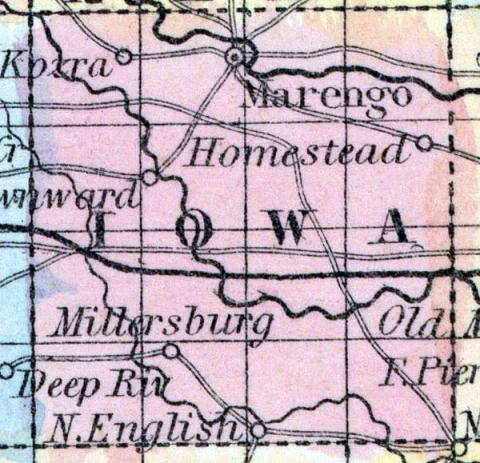IOWA, a new county in the S. E. central part of Iowa, has an area of 576 square miles. The Iowa river, from which the name is derived, flows eastward through the northern part, and the North fork of English river traverses the southern part of the county. The principal streams, besides these, arc Beaver, Oldman's, and Richmond creeks. The county is said to have a fertile soil, a healthy climate, and good timber. In 1850, Iowa county produced 31,145 bushels of Indian corn, 5535 of wheat. The projected railway route from Davenport to Council Bluffs passes through the county. Capital, Marengo. Pop., 822. (Baldwin's New and Complete Gazetteer of the United States..., 1854)
IOWA COUNTY North of Keokuk, and west of Johnson, is well supplied with timber along the Iowa River, which stream, with the north fork of English River, Old Man's Creek, Beaver and Richmond Creeks, affords an abundance of water for all purposes. The soil is admirably adapted for farming and grazing. The county seat, Marengo, is situated upon the Iowa River, in the northern part of the county. There are settlements at Kozta, Homestead, Downard, Millersburg and North English Post Offices. The Mississippi and Missouri railroad passes through almost the centre of the county. (Iowa As It Is in 1855; A Gazetteer for Citizens..., 1855)
IOWA COUNTY Is situated in the eastern part of the State, being the fourth west of the Mississippi River, and the fourth north of the State of Missouri. It is bounded on the north by Benton county, on the east by Johnson, on the south by Washington and Keokuk, and on the west by Poweshiek. It is twenty-four miles square.
The county is watered by the following streams, flowing in a southeasterly direction, upon the banks of which there is an average growth of good timber, to wit. Iowa River, Big and Little Bear Creeks, Old Man's Creek, Honey Creek, North English, Middle English, Gritter Creek, Hilton Creek and Deep River.
There is stone in sufficient quantities for building purposes. “Within the limits of Iowa county we have not been able to find any other outcrop of the Hamilton rocks than those on the Iowa River. Beyond township 81, range 7, there are no rocks seen in place, except a few patches of sandstone, until we reach Tama county. Not a single exposure of rock was discovered on any of the smaller streams south of the Iowa, although diligent search was made along the vallies of Old Man's Creek, and the north fork of the English River. Through Iowa county, low bluffs border the river at a distance of from half a mile to a mile from the stream; but they are made up of finely comminuted materials, without even so much as a loose slab or fragment of rock to indicate the character of the underlying strata. Although it would appear from the general direction of the lines of outcrop in this region, so far as they can be ascertained, that rocks of Hamilton age predominate over the large surface in Iowa and Benton counties, over which no exposure of the strata are visible; still, there is good reason to believe that there may be considerable patches of carboniferous strata existing beneath the superficial covering of detritus. These may be either the remains of a deposit once spread continuously over a large extent of surface, or, more probably, limited deposits in pre-existing depressions of the Hamilton strata.”—Geology of Iowa.
Coal has not as yet been discovered, but it is believed that it exists in large quantities, and needs only enterprise and capital to develop rich veins. It is well watered, and just rolling enough to make it one of the best and most desirable farming counties in the State, and is fast settling up by enterprising people, from adjacent and Eastern States.
The first house built in this county was by Ed. Ricord, in what is now Green township. The first settlement was made at or near what is now known as Homestead, by Lineas Niles, one Cleveland, and John Burget.
The first settlement in and near Marengo, was made by Robert McKee, Amos Crocker, Absalom Washington, Charles Kitchen, William Downard and Ransom F. Mason. The Kitchen Brothers put up the first saw mill in the county on Bear Creek, about five miles southwest from Marengo. One Kirkpatrick put up the first tavern in the county, at Marengo. John Hill was the first blacksmith that put up a shop and did work in the county. William Downard and H. H. Hull brought the first stock of goods to the county, and sold them at Marengo. Robert McKee was the first treasurer and recorder and clerk of the District Court after the organization of the county. The first white child was born to Robert McKee. The first death was a child of one Snyder, a twin.
The Pottawattamie and Musquawka tribes of Indians inhabited the country in and around Marengo, but being peaceable, they never molested the early settlers, save when some venturesome trader gave them whisky in exchange for their furs, under the influence of which, they, as well as the pale faces in like condition, were disposed to be quarrelsome. There is now but a handful, as it were, left of these once warlike and powerful tribes; they are located on a reserve, some forty miles west of Marengo, in Tama county. (Hair's Iowa State Gazetteer..., 1865)

